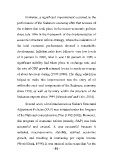Page 537 - 2016 - Vol. 40
P. 537
However, a significant improvement occurred in the
performance of the Sudanese economy after that because of
the reforms that took place in the macro-economic policies
since July 1996 in the framework of the implementation of
economic structural reform strategy, where the indicators of
the total economic performance showed a remarkable
development. Inflation rates have fallen to very low levels
of 8 percent in 2000, after it was 166 percent in 1996 a
significant stability had taken place in exchange rate, and
the rate of GDP growth returned to rise to reach an average
of about 6percent during (1997-2000). The thing which has
helped to make this improvement was the entry of oil
within the sect- oral components of the Sudanese economy
since 1998, as well as its entry within the structure of the
Sudanese exports since 1999 (Almosharaf and Tain, 2014).
Second wave of reforms known as Sudan's Structural
Adjustment Policies (SAP) was initiated under the Program
of the National comprehensive Plan (1992-2002). However,
this program of economic reform (namely, SAP) was both
successful and unusual. It was successful because it
restarted macroeconomic stability, revived economic
growth, and resulting in increasing per capita income
(World Bank, 1998). It was unusual in the sense that "as the
- 49 -

